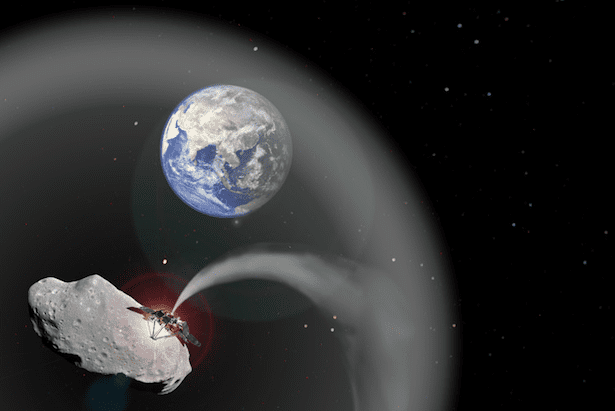According to the UN Intergovernmental Panel on Climate Change, climate change models suggest that average global temperatures will likely rise by 2 to 11.5 degrees F (1.1 to 6.4 degrees C) by the end of this century. The consequences of an increase of just a few degrees are dire. Apparently, taking clear and effective steps to reduce global warming, like cutting down carbon emissions and stimulating carbon absorption, are almost impossible in today’s politically inept world, and instead we ought to seek salvation in SciFi project in space. The latest such audacious idea comes from Scottish scientists who suggest that a massive dust cloud spewed away from a neighboring asteroid, just at the right distance away from Earth and concentration, could filter away some of the sun’s radiation and cool the planet down.

The latest form of solar shield: an asteroid whose dust is stabilized beyond Earth through gravity’s pull (Charlotte Lücking, based on images from ESA and NASA)
It’s not like this is the craziest anti-global warming scientific project we’ve ever heard, though. There have been many voices advocating geoengineering, massive engineering projects with a global scale impact, as a solution for today’s shaken climate, and the tomorrow’s uncertain future. Geo-engineering plankton blooms, via marine iron fertilization, are said to absorb some of the excess carbon dioxide we’ve emitted into the atmosphere. Another idea is to place some huge pipes in oceanic depths, in order to bring the nutrient-rich waters from the ocean floor to the surface where they might mix and stimulate the growth of those algae blooms. Or, just what might be the craziest one yet, deploying a giant mirror in space as a means of reflecting the sun’s radiation. A mirror just as this, or a set of connecting mirrors, would have to be huge in order to disperse enough radiation for the project to become feasible – yet mankind has been toiling away for the past decade to build a tiny space station. Seeing how the cost per pound for space launches is in the thousands of dollars range, this sounds plain wrong.
Having in mind just these past few examples of geoengineering, deploying a giant dust cloud, kept in position by an asteroid’s gravity, in order to shade the Earth might not sound that preposterous … or does it? A similar idea has been proposed in past, in the form of a simple dust cloud which could block the sun’s radiation, however the risk of getting dispersed by the gravitational pull of the sun, moon and planets is too great to work. The gravitational pull of an asteroid, though, would lock such a cloud dust in position and make the idea work, in theory at least .
“I would like to make it clear that I would never suggest geoengineering in place of reducing our carbon emissions,” said Russell Bewick, a space scientist at the University of Strathclyde in Scotland. Instead, he said, “We can buy time to find a lasting solution to combat Earth’s climate change. The dust cloud is not a permanent cure, but it could offset the effects of climate change for a given time to allow slow-acting measures like carbon capture to take effect.”
The key lies in canceling out external gravitational pull. In a sort of gravitational tug-of-war, lies a point where the sun and Earth’s gravitation cancel themselves out – this is called the Lagrange point L1, located at around four times the distance from the Earth to the moon.
The researchers calculate that the largest near-Earth asteroid, 1036 Ganymed, could maintain a dust cloud large enough to block out 6.58 percent of the solar radiation that would normally reach Earth, more than enough to combat any current global warming trends. The asteroid, once in place, would be fitted with a “mass driver,” a kind of electromagnetic catapult that would provide the power both to move the asteroid into position and to blast the cloud of dust, once created, from its surface.
Not that simple, as you might imagine
“The company Planetary Resources recently announced their intention to mine asteroids,” Bewick said. “The study that they base their plans on reckons that it will be possible to capture an asteroid with a mass of 500,000 kilograms (1.1 million lbs.) by 2025. Comparing this to the mass of Ganymed makes the task of capturing it seem unfeasible, at least in everything except the very far term. However, smaller asteroids could be moved and clustered at the first Lagrange point.”
“A very large asteroid is a potential threat to Earth, and therefore great care and testing would be required in the implementation of this scenario,” Bewick said. “Due to this, the political challenges would probably match the scale of the engineering challenge. Even for the capture of much smaller asteroids, there will likely be reservations from all areas of society, though the risks would be much less.”
Add the current economical, political and the simple fact that the world simply can not be mobilized towards a common, global goal in today’s society and leaders’ philosophy, to the slew of challenges revolving around the project.
Scientists will detail their findings in the Nov. 12 edition of the journal Advances in Space Research.









